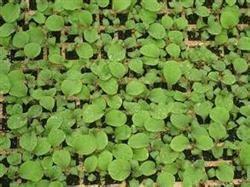Eggplant deficiency and its remedial measures

In the process of eggplant growth and development, once there is a lack of certain elements, the external morphology of the plant will generally show the corresponding symptoms of element deficiency, which is often used as the basis for the diagnosis of element deficiency in production. When the eggplant is nitrogen deficient, the leaf color becomes lighter, the old leaf yellowing, when it is serious, it dries up and falls off, the bud stops developing and turns yellow, and the heart leaf becomes smaller. Remedial measures: when the plant is found to be nitrogen deficient, timely apply available nitrogen fertilizer such as urea, ammonium bicarbonate or human feces and urine, or foliar spray 0.3% 0.5% urea solution. When eggplant is calcium deficient, the plant grows slowly, the growth point is deformed, the leaf margin of the young leaf is green, and the reticular vein of the leaf turns brown, showing a ferruginous leaf. Remedial measures: when it is found that the plant is deficient in calcium, apply calcium fertilizer in time, or spray foliar with 20% calcium chloride solution, once every 5 days, 2 times in a row. When the eggplant is phosphorus deficient, the stem is slender, the fiber is well developed, the flower bud differentiation and fruiting period is prolonged, the leaf becomes smaller, the color becomes darker, and the leaf vein is red. Remedial measures: when phosphorus deficiency was found, 0.2% potassium dihydrogen phosphate solution or 0.5% calcium superphosphate leaching solution was sprayed on the leaves. When eggplant is potassium deficient, the heart leaf becomes smaller, grows slowly and the leaf color becomes lighter at the initial stage; in the later stage, the leaf veins lose chlorosis, yellow-white patches appear, and the leaf tip leaf margin gradually dries up. Remedial measures: when it is found that the plant is deficient in potassium, potassium fertilizer and organic fertilizer are applied in time, generally, potassium sulfate or potassium chloride is used for 10: 15kg per mu, ditched and applied on both sides of the plant; with 0.2%-0.3% potassium dihydrogen phosphate solution or 10% plant ash leaching solution leaf spraying. When the eggplant is magnesium deficient, the tissue near the leaf vein, especially the main leaf vein, turns yellow, the leaf becomes green, the fruit becomes smaller, and the development is poor. In production, there are more remedial measures for magnesium deficiency of eggplant: when the plant is magnesium deficient, add magnesium fertilizers, such as magnesium sulfate, magnesium chloride, magnesium nitrate and so on, these fertilizers are soluble in water and are easy to be absorbed and utilized. It can also be foliar sprayed with 1%-3% magnesium sulfate solution or 1% magnesium nitrate solution. Iron deficiency when eggplant is iron deficient, young leaves and new leaves are yellowish white, and leaf veins remain green. Iron deficiency often occurs under the condition that the soil is acidic, fertile and wet. Remedial measures: when iron deficiency is found in plants, foliar spraying with 0.5%-1% ferrous sulfate solution. When the eggplant is boron deficient, it yellowed and withered downward from the top leaf, the apical stem and petiole were broken, the interior became black, and there were cork-like cracks on the stem. Remedial measures: when boron deficiency is found in plants, 0.05%-0.2% borax solution or boric acid solution is sprayed on the leaves in time. When eggplant is deficient in manganese, the veins of the new leaves are yellowish green and soon turn brown, and the veins are still green. Remedial measures: when manganese deficiency is found in plants, foliar spraying with 1% manganese sulfate solution. When eggplant is zinc deficient, the small leaves are tufted, and macula occurs on the new leaves, which gradually develops to the leaf margin, resulting in the yellowing of the whole leaf. Remedial measures: when zinc deficiency is found in plants, 0.1% zinc sulfate solution is sprayed on the leaves. Molybdenum deficiency eggplant when molybdenum deficiency begins when the fruit is enlarged, macula occurs between the leaf veins and the leaf margin curls to the inside. Remedial measures: when molybdenum deficiency is found, foliar spray of 0.01%-0.1% ammonium molybdate solution is used.
- Prev

The reason why Pleurotus ostreatus can't produce mushroom and its solution
The reason why Pleurotus ostreatus can't produce mushroom and its solution
- Next

Key points of eggplant Seedling stage Management
After 70% of the seeds in the seedbed emerge, remove the plastic film covered on the soil of the bed. Spray water frequently to keep the soil moist. During this period, we should pay attention to the control of underground pests, the method is to use 80% dichlorvos EC, diluted with 1 200 ~ 1500 times water and poured on the seedbed. When the seedling has 2 true leaves, it is necessary to divide the seedlings and prepare them.
Related
- Where is it suitable to grow horseradish in China? it is expected to see the middle altitude horseradish in Alishan.
- How to prevent tomato virus disease reasonably? (Control methods included)
- Many people like to plant towel gourd on the balcony. What are the main points of this method and management?
- What crops can chili peppers be mixed with?
- Fertilization techniques and matters needing attention in Tomato
- What are the grafting techniques for peach seedlings in spring?
- Harm and control methods of root swelling disease of Chinese cabbage
- What are the pests of sweet potatoes? How to prevent and cure it?
- Symptoms, causes and Control methods of navel Rot in Tomato
- The cause of "Cucumber rotten bibcock" in Farmers' planting Cucumber and its Control Plan

